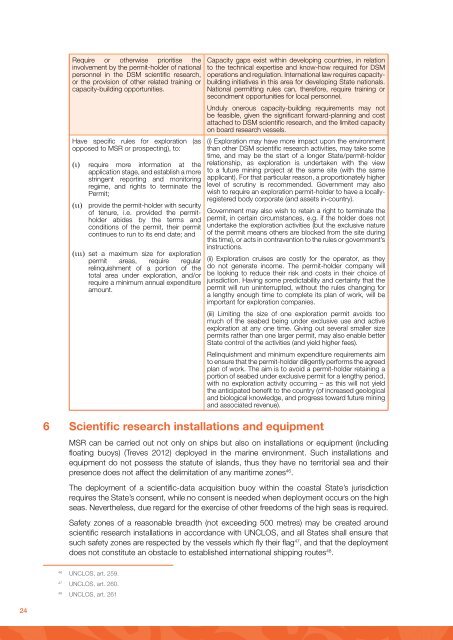REGIONAL SCIENTIFIC RESEARCH GUIDELINES
RSRG2016
RSRG2016
You also want an ePaper? Increase the reach of your titles
YUMPU automatically turns print PDFs into web optimized ePapers that Google loves.
Require or otherwise prioritise the<br />
involvement by the permit-holder of national<br />
personnel in the DSM scientific research,<br />
or the provision of other related training or<br />
capacity-building opportunities.<br />
Have specific rules for exploration (as<br />
opposed to MSR or prospecting), to:<br />
(i) require more information at the<br />
application stage, and establish a more<br />
stringent reporting and monitoring<br />
regime, and rights to terminate the<br />
Permit;<br />
(ii) provide the permit-holder with security<br />
of tenure, i.e. provided the permitholder<br />
abides by the terms and<br />
conditions of the permit, their permit<br />
continues to run to its end date; and<br />
(iii) set a maximum size for exploration<br />
permit areas, require regular<br />
relinquishment of a portion of the<br />
total area under exploration, and/or<br />
require a minimum annual expenditure<br />
amount.<br />
Capacity gaps exist within developing countries, in relation<br />
to the technical expertise and know-how required for DSM<br />
operations and regulation. International law requires capacitybuilding<br />
initiatives in this area for developing State nationals.<br />
National permitting rules can, therefore, require training or<br />
secondment opportunities for local personnel.<br />
Unduly onerous capacity-building requirements may not<br />
be feasible, given the significant forward-planning and cost<br />
attached to DSM scientific research, and the limited capacity<br />
on board research vessels.<br />
(i) Exploration may have more impact upon the environment<br />
than other DSM scientific research activities, may take some<br />
time, and may be the start of a longer State/permit-holder<br />
relationship, as exploration is undertaken with the view<br />
to a future mining project at the same site (with the same<br />
applicant). For that particular reason, a proportionately higher<br />
level of scrutiny is recommended. Government may also<br />
wish to require an exploration permit-holder to have a locallyregistered<br />
body corporate (and assets in-country).<br />
Government may also wish to retain a right to terminate the<br />
permit, in certain circumstances, e.g. if the holder does not<br />
undertake the exploration activities (but the exclusive nature<br />
of the permit means others are blocked from the site during<br />
this time), or acts in contravention to the rules or government’s<br />
instructions.<br />
(ii) Exploration cruises are costly for the operator, as they<br />
do not generate income. The permit-holder company will<br />
be looking to reduce their risk and costs in their choice of<br />
jurisdiction. Having some predictability and certainty that the<br />
permit will run uninterrupted, without the rules changing for<br />
a lengthy enough time to complete its plan of work, will be<br />
important for exploration companies.<br />
(iii) Limiting the size of one exploration permit avoids too<br />
much of the seabed being under exclusive use and active<br />
exploration at any one time. Giving out several smaller size<br />
permits rather than one larger permit, may also enable better<br />
State control of the activities (and yield higher fees).<br />
Relinquishment and minimum expenditure requirements aim<br />
to ensure that the permit-holder diligently performs the agreed<br />
plan of work. The aim is to avoid a permit-holder retaining a<br />
portion of seabed under exclusive permit for a lengthy period,<br />
with no exploration activity occurring – as this will not yield<br />
the anticipated benefit to the country (of increased geological<br />
and biological knowledge, and progress toward future mining<br />
and associated revenue).<br />
6 Scientific research installations and equipment<br />
MSR can be carried out not only on ships but also on installations or equipment (including<br />
floating buoys) (Treves 2012) deployed in the marine environment. Such installations and<br />
equipment do not possess the statute of islands, thus they have no territorial sea and their<br />
presence does not affect the delimitation of any maritime zones 46 .<br />
The deployment of a scientific-data acquisition buoy within the coastal State’s jurisdiction<br />
requires the State’s consent, while no consent is needed when deployment occurs on the high<br />
seas. Nevertheless, due regard for the exercise of other freedoms of the high seas is required.<br />
Safety zones of a reasonable breadth (not exceeding 500 metres) may be created around<br />
scientific research installations in accordance with UNCLOS, and all States shall ensure that<br />
such safety zones are respected by the vessels which fly their flag 47 , and that the deployment<br />
does not constitute an obstacle to established international shipping routes 48 .<br />
46<br />
UNCLOS, art. 259.<br />
47<br />
UNCLOS, art. 260.<br />
48<br />
UNCLOS, art. 261<br />
24


